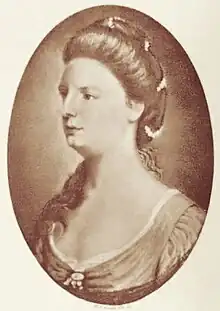Mary de Bode
Mary de Bode born Mary Kynnersley was born in Loxley Hall, Staffordshire. She became a baroness by marriage. She became rich when her husband was given estates in north-west France, but her prospects were ruined by the French Revolution. She only escaped with her life and that of her family. Her British roots were the basis of an unsuccessful court case to receive compensation for their lost lands which ran for about 46 years.

Life

She was the fourth daughter of Penelope Wheeler and Thomas Kynnersley, the owners of Loxley Hall.[1][2] Her birth date is unknown but she married in 1775 at St Marylebone Church and at the French Embassy in London. Her husband was Auguste Louis Frederick de Bode, a baron in the nobility of the Holy Roman Empire. He had some notable ancestors but he was not rich. He was born in Germany and worked as a soldier in the Royal Deux-Ponts Regiment in the service of King Louis XVI of France. She had met him while in Flanders.[3] He was a Catholic and she a member of the Church of England.[2]
In 1777 she gave birth to their first child, Clement, in Staffordshire.[4]
They believed that their futures were assured when the Baron was given the fiefdom of Soultz-sous-Forêts by the Archbishop of Cologne (Maximilian Franz of Austria). Soultz-sous-Forêts is a commune in the Alsace in north-eastern France. In December 1788 she and Baron de Bone arrived in Soultz-sous-Forêts.[2] She described Soultz-sous-Forêts as a land "flowing with Corn and oil and wine."[4] The Baroness wrote a large number of letters[1] and she was fluent in French, German, Italian and English.[2]
They hoped that the French Revolution would not affect them but at the end of 1794 the Baron and Baroness de Bone moved out of the town. They lived at different locations in Germany before they mistakenly returned. They were lucky to make a quick escape over the mountains. However they left all their riches and five of their children behind them. They were helped by the Baron's sister who was the abbess of Altenburg Abbey and in time she was reunited with all of her children.[2]
Death and legacy
She died in 1812 in Moscow. Her eldest son Clement, and afterwards his son, tried but failed for about 46 years[4] to regain the rights and riches they lost in the 1790s.[4] In June 1854 the case of the de Bode family was debated in the British Houses of Parliament after it was introduced by Montague Chambers recommending that France should be obliged to award compensation. The case was based on international treaties under which France had agreed to pay compensation to British subjects who had incurred losses during their revolution. Clement, Baron de Bode and his mother were both born in Staffordshire.[5]
William S. Childe-Pemberton wrote her biography The Baroness de Bode, 1775-1803 which was published in 1900.[6]
References
- Childe-Pemberton, William Shakespear (1900). The Baroness de Bode, 1775-1803. University of California Libraries. London, New York : Longmans, Green.
- Matthew, H. C. G.; Harrison, B., eds. (23 September 2004), "The Oxford Dictionary of National Biography", The Oxford Dictionary of National Biography, Oxford: Oxford University Press, doi:10.1093/ref:odnb/71334, retrieved 8 August 2023
- Childe-Pemberton, William Shakespear (1900). The Baroness de Bode, 1775-1803. University of California Libraries. London, New York : Longmans, Green. p. 3.
- Lobban, Michael (31 March 2016), Godfrey, Mark (ed.), "The commissioners for claims on France and the case of the Baronde Bode, 1815–1861", Law and Authority in British Legal History, 1200–1900 (1 ed.), Cambridge University Press, pp. 212–249, doi:10.1017/cbo9781316402795.011, ISBN 978-1-316-40279-5, retrieved 8 August 2023
- "THE CASE OF THE BARON DE BODE. (Hansard, 20 June 1854)". api.parliament.uk. Retrieved 8 August 2023.
- Childe-Pemberton, William Shakespear (1900). The Baroness de Bode, 1775-1803, by William S. Childe-Pemberton... Longmans, Green & Company.